Pedro Pablo Rubens
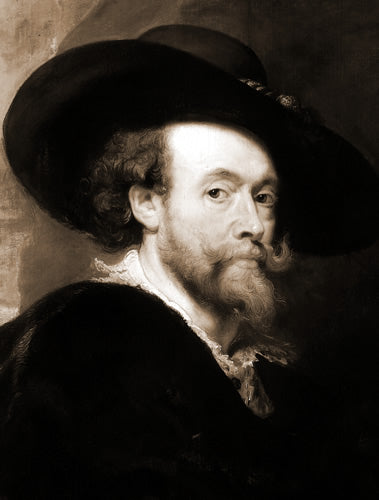
| Full name: | Peter Paul Rubens. |
|---|---|
| Known in Spain as: | Pedro Pablo Rubens. |
| Also known as (Dutch): | Pieter Paul Rubens. |
| Birth: | 1577, Siegen, Germany. |
| Death: | 1640, Antwerp, Bélgica. |
| Style: | Baroque, Flemish School |
European painter, a very prominent figure in the Baroque style of the Flemish school, born in the territory of the Holy Roman Empire, now Germany, of Catholic confession. Under his tutelage, he had as pupils prominent artists like Anton van Dyck.
Educated in a humanist environment and immersed in the Renaissance mentality, which marked his evident admiration for the beauty of ancient Greece. A believer and spiritual man, he thought his painting was inspired by God and an important collaborator in the Christian message, which in turn led him to be a champion of the Catholic Counter-Reformation.
Rubens' brush is decisive and graceful; it seeks to capture a moment within an event, he accomplished this task with such acuity, that from the beginnings of his career he was recognized by the leading Flemish pictorial formators, the nobility, and the monarchy of the time
Paintings by Rubens
Almost all of Rubens' paintings are of 3 genres: religious, historical, and mythological painting. Occasionally he also painted portraits and hunting scenes.
Extremely disciplined and prolific, like few artists in history, he has 1403 verified paintings, and many others that were produced under his supervision in his workshop. Also at least 16 lost works. © diCrox
-

También conocido como: Descendimiento de CristoAutor: Pedro Pablo RubensAño: 1612 - 1614Estilo: BarrocoTipo: CuadroTécnica: ÓleoSoporte: LienzoSe encuentra en: La Catedral de Amberes, BélgicaEs la pieza central de un tríptico donde se muestran 3 momentos de la historia de Jesús. La composición muestra como figura principal a Cristo presentado sobre una tela blanca en disposición oblicua, haciendo patente el descendimiento gradual desde lo alto de la cruz a la tierra. Ayudado por los personajes bíblicos que por tradición se consideran que estuvieron presentes en ese momento, entre ellos: la Virgen María, José de Arimatea, Juan (el apóstol) y Nicodemo.
Se considera una obra maestra del estilo barroco flamenco, las figuras en disposición armónica, el dramatismo y el movimiento repletan el lienzo, lleno de detalles. La luz sugiere al espectador donde dirigir la mirada.
-

Autor: Pedro Pablo RubensAño: 1939Título en inglés: The Judgement of ParisEstilo: BarrocoGénero: Pintura mitológicaTipo: CuadroTécnica: ÓleoSoporte: LienzoSe encuentra en: Prado Museum, MadridSe trata de una escena mitológica, muchas veces plasmada por el artista, aunque sólo hizo 2 versiones grandes y elaboradas de la misma, de las cuales esta es la segunda. Tres años antes había pintado esta otra versión de "El juicio de París", que actualmente se encuentra en la National Gallery de Londres.
"Paris" es un personaje mitológico griego, príncipe de Troya. En este pasaje se encuentra el mismo dirimiendo sobre la belleza de las tres doncellas que se le presentan.
El realismo y apariencia libertina de la obra chocaron con la mentalidad de los más conservadores del siglo XVIII, hasta el punto que se ordenó su destrucción por considerarse indecente, en la corte de Carlos III de España, orden que pronto fue retirada, tras una negociación que dejó la obra escondida al público durante años.
-
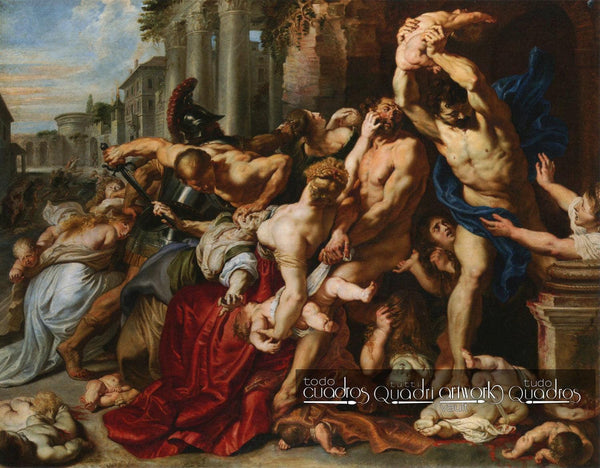
También conocido como: Matanza de los InocentesAutor: Pedro Pablo RubensAño: 1612Estilo: BarrocoTipo: CuadroTécnica: ÓleoSoporte: LienzoSe encuentra en: Galería de Arte de Ontario, CanadáSe trata de la escena bíblica conocida como "matanza de los Inocentes", presente en el evangelio según San Mateo, capítulo 2; cuando el Rey romano Herodes, en tiempos del nacimiento de Jesús, manda a matar a todos los niños judíos recién nacidos, para asegurarse de aniquilar al teórico mesías sobre el cual le habían advertido, frente a este suceso el padre putativo de Jesús, José, se exilia en Egipto hasta que pase el peligro. Según el relato, el pueblo judío fue diezmado al extremo matando a todos los niños varones hasta 2 años.
La ejecución de la obra es impecable, las anatomías, el movimiento y la carga emotiva de los personajes están a un nivel muy alto, considerado sublime y uno de los cuadros más perfectos de la historia, esta última afirmación viene apoyada por el precio que la obra alcanzó en 2001, el más caro hasta la fecha para un cuadro anterior al impresionismo: 49,5 millones de libras esterlinas, subastado en la casa Sotheby's de Londres.
-

Título en inglés: The Fall of PhaetonAutor: Pedro Pablo RubensAño: 1605Estilo: BarrocoTipo: CuadroTécnica: ÓleoSoporte: LienzoSe encuentra en: Galería Nacional de Arte, Washington, EE. UU.Esta obra fue pintada en Roma, al comienzo de la carrera del artista. Describe un momento en la mitología griega donde Faetón ruega a su padre, Apolo, que le permita conducir los carros de fuego. Cuando Apolo después de muchas reticencias aceptó entregar las riendas de los carros a su hijo, se confirmó uno de sus más grandes temores, que Faetón no tenía el temple y fortaleza necesarios para mantener el rumbo de los carros, lo cual desató el caos en el clima de la tierra, mientras unos lugares se congelaban, otros ardían con el calor.
A los comienzos de su carrera, P. P. Rubens ya era un conocedor y amante de los ideales filosóficos clásicos, en sus viajes a las principales ciudades italianas a principios de 1600, ahondó más en sus conocimientos del mundo antiguo, la pintura renacentista y los autores más cercanos al modelo clásico, entre ellos, Rafael, Da Vinci Y Miguel Ángel. Lo que se hace patente en la estética, el movimiento y dramatismo de este cuadro.
-
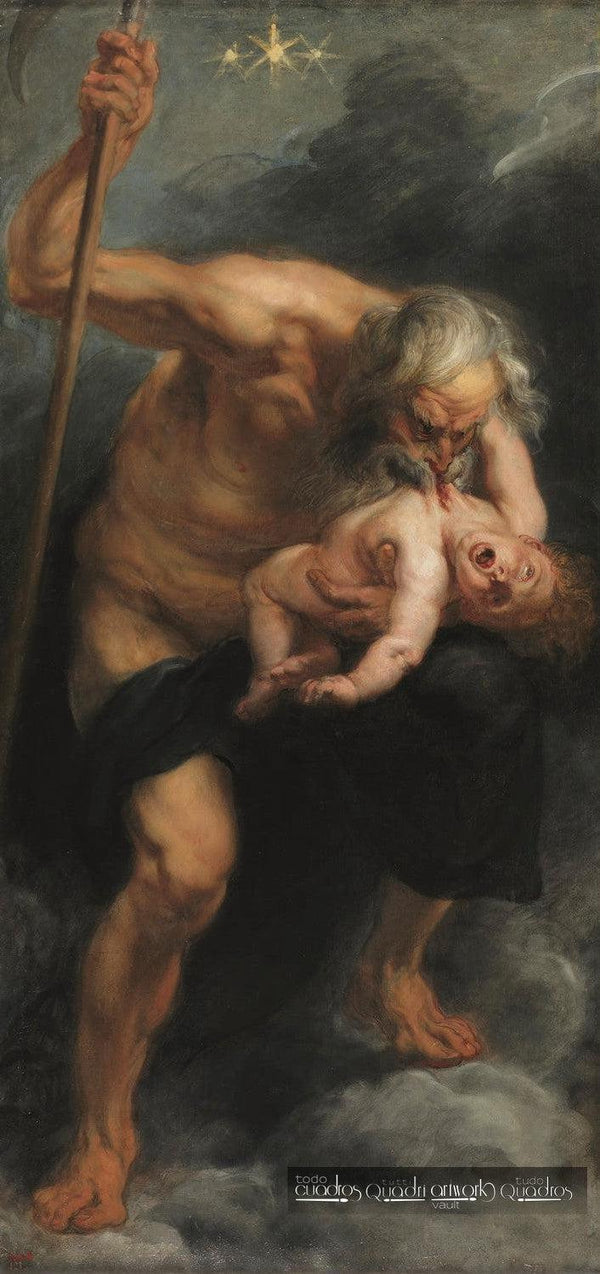
También conocido como: Saturno devorando a su hijoAutor: Pedro Pablo RubensAño: 1636Estilo: BarrocoGénero: Pintura mitológicaTipo: CuadroTécnica: ÓleoSoporte: LienzoSe encuentra en: El Museo del Prado, Madrid.Es una obra de gran realismo, que muestra al dios "Saturno", de la mitología romana y con frecuencia asimilado a otros dioses griegos. En la escena, el personaje está devorando a uno de sus hijos, ya que fue informado que uno de ellos lo destronaría, el único que quedó vivo fue Zeus, el cual efectivamente lo destronó en funciones e importancia.
Conocida es la versión de Goya del mismo título, aunque no demuestra ni la sombra de la pericia exhibida por Rubens.
-
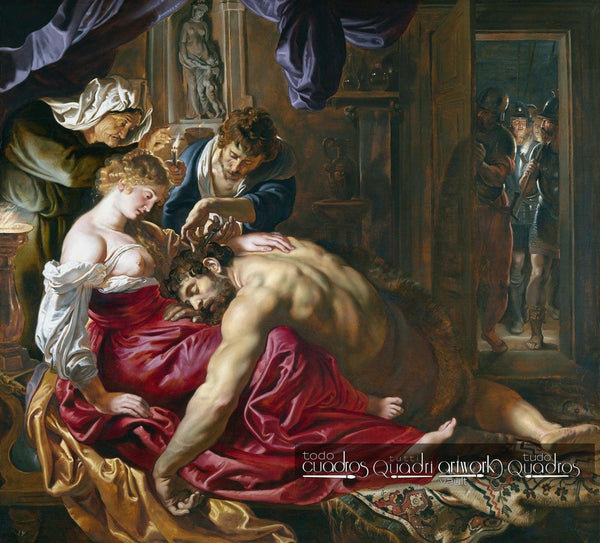
Título en inglés: Samson and DelilahAutor: Pedro Pablo RubensAño: 1610Estilo: BarrocoTipo: CuadroTécnica: ÓleoSoporte: LienzoSe encuentra en: National Gallery, LondresEscena pictórica del pasaje bíblico del antiguo testamento, en que Dalila traiciona al héroe hebreo Sansón, quien estaba enamorado de ella, cortándole el pelo después que este le confesara que su cabellera era la fuente de su fuerza.
El suceso transcurre en una habitación oscura, casi solamente alumbrada por la vela que sostiene la anciana a la izquierda, en el fondo se aprecia una pequeña estatua de la diosa Venus, a la derecha los soldados esperando el momento propicio para apresarlo, una vez haya perdido su poder.
-
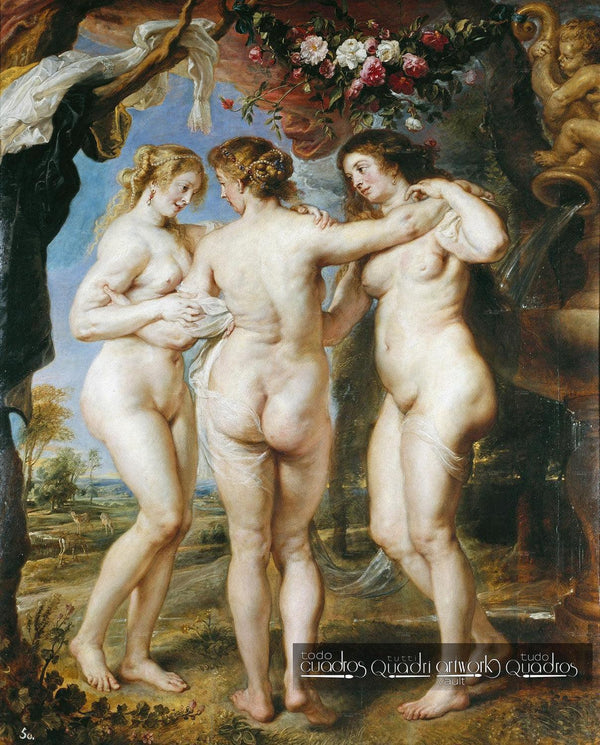
También conocido como: Las GraciasAutor: Pedro Pablo RubensAño: 1639Estilo: BarrocoTipo: CuadroTécnica: ÓleoSoporte: TablaSe encuentra en: Museo Nacional del Prado, MadridEsta obra muestra una imagen puramente barroca de los personajes mitológicos llamados "Gracias" o "Cárites", estas gobiernan el ámbito de la belleza la seducción y la sensualidad. Son personajes genéricos que se pueden referir tanto a hijas de Zeus, como a otros personajes menores, pero que cultivan las mismas cualidades.
Este trío de personajes ha sido ampliamente interpretado en la pintura y escultura, algunas de las versiones más conocidas son las de Rafael Sanzio y Picasso.
-
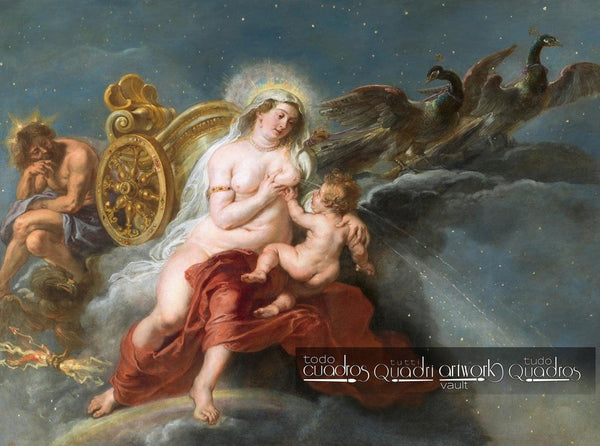
Autor: Pedro Pablo RubensAño: 1636Estilo: BarrocoTipo: CuadroTécnica: ÓleoSoporte: LienzoSe encuentra en: El Museo del Prado, MadridTela encargada por Felipe IV para la decoración de su casa de recreo en El Pardo, Madrid. Se aprecian los personajes pertenecen a la mitología romana, el relato pretende explicar el origen de nuestra Vía Láctea, la cual nace de la leche desperdigada por el espacio, que un día la diosa Juno dio a su bebé Hércules, también hijo de Júpiter, quien aparece pensativo a la izquierda.
-

Autor: Pedro Pablo RubensAño: 1635Estilo: RococóTipo: CuadroTécnica: ÓleoSoporte: LienzoSe encuentra en: El Museo del Prado, Madrid.Muestra una situación de fantasía, donde personas corrientes de la época, parecen converger en un lugar idílico. Rodeados por angelitos y con estatuas de personajes mitológicos.
Esta obra representa una inclinación notoria al Rococó. Rubens muestra aquí su pericia e inclinación a los modelos de belleza clásico, así como a el gusto por la ornamentación generosa.
-

Autor: Pedro Pablo RubensAño: 1629Estilo: BarrocoTipo: CuadroTécnica: ÓleoSoporte: LienzoSe encuentra en: Museo del Prado, MadridReproducción pintada por Rubens, de la pintura de Tiziano del mismo título, en un viaje a España, donde conoció una buena parte de su obra. La composición es casi idéntica, sólo varía en algunos aspectos ornamentales.
-
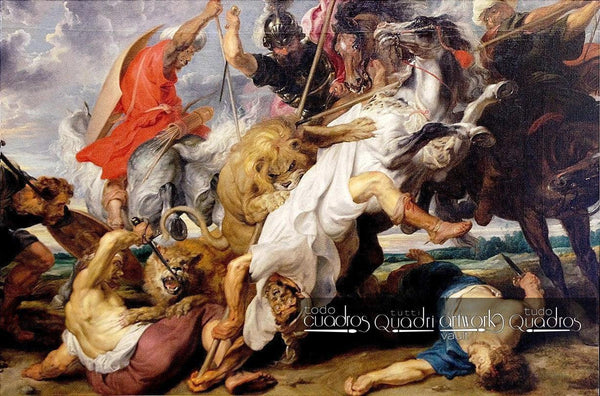
Título en alemán: LöwenjagdAutor: Pedro Pablo RubensAño: circa 1621Estilo: BarrocoTipo: CuadroTécnica: ÓleoSoporte: LienzoSe encuentra en: Pinacoteca Antigua de Múnich, Alemania"Gracia y violencia", con estas palabras se refería el propio artista a esta obra, la cual fue encargada por John Digby, conde de Bristol en Inglaterra.
La composición es fabulosa, muestra la lucha entre el hombre y la bestia, 7 personaje ataviados con indumentaria romana y árabe, luchan contra 2 leones, los cuales aún no ha sido heridos. El movimiento y la tensión del motivo es notable, se considera una obra maestra del barroco europeo.
-
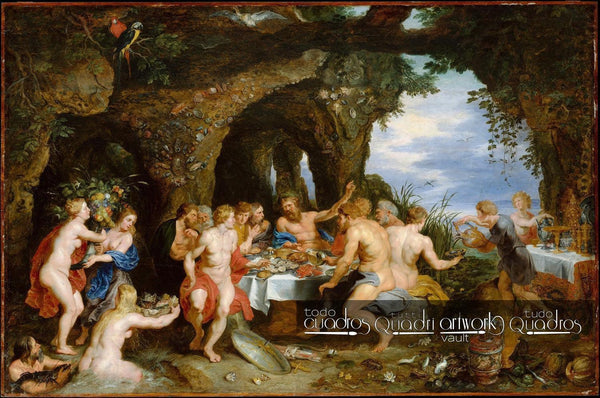
Título en inglés: The Feast of AcheloüsAutor: Pedro Pablo Rubens con la colaboración de Jan Brueghel el ViejoAño: 1615Estilo: BarrocoTipo: CuadroTécnica: ÓleoSoporte: TablaSe encuentra en: Museo MET, Nueva YorkJan Brueghel y P. P. Rubens eran amigos y colaboraron en varias pinturas entre 1610 y 1620, principalmente de temática mitológica. Esta obra muestra una clara reminiscencia de las esculturas clásicas griegas; en el centro el dios del río Aqueloo (del mismo nombre) conversa con Teseo (el héroe griego).
-

Autor: Pedro Pablo RubensAño: 1618Estilo: BarrocoGénero: Pintura religiosaTipo: CuadroTécnica: ÓleoSoporte: LienzoSe encuentra en: Museo Gemäldegalerie, BerlínSan Sebastián es uno de los trabajos más simbólicos del pintor, la tela muestra las características clásicas de sus trazos: personajes realistas, movimiento, anatomías sinuosas y colores fuertes.
Order it in the section of Rubens oil paintings
Related famous painters: relacionados:
↑Back to Top
